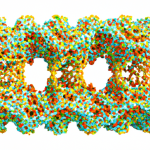How Many Offspring Does Asexual Reproduction Produce: Exploring the Fascinating World of Reproduction
Asexual reproduction is a remarkable phenomenon observed in various organisms, where offspring are produced without the involvement of gametes or the fusion of genetic material from two parents. In this intriguing process, a single parent organism has the ability to generate genetically identical offspring, known as clones. But have you ever wondered how many offspring asexual reproduction can produce? Let’s delve into this fascinating world of reproduction and find out.
Asexual reproduction methods vary across different organisms, but they all share the common characteristic of producing offspring without the need for fertilization. One of the most common forms of asexual reproduction is binary fission, which is observed in bacteria and other single-celled organisms. During binary fission, the parent cell divides into two identical daughter cells, each capable of growing into a new organism. This process allows for exponential growth, as each generation of offspring can undergo binary fission, resulting in a rapid increase in population size.
Another form of asexual reproduction is budding, commonly seen in organisms such as yeast and hydra. Budding involves the outgrowth of a small bud or offspring from the parent organism. Over time, the bud grows and eventually detaches from the parent, becoming an independent organism. Depending on the species and environmental conditions, budding can produce a variable number of offspring. Some organisms may produce only one offspring at a time, while others can generate multiple buds simultaneously.
In plants, asexual reproduction can occur through various mechanisms, including runners, rhizomes, and plantlets. Runners are horizontal stems that grow above the ground, producing new plants at nodes along their length. Rhizomes, on the other hand, are underground stems that give rise to new shoots and roots. Plantlets are miniature versions of the parent plant that develop on specialized structures, such as leaves or stems, and can eventually detach to form independent individuals. The number of offspring produced through these methods can vary depending on the species and environmental factors.
One of the advantages of asexual reproduction is the potential for rapid population growth. Since offspring are genetically identical to the parent, they inherit all the favorable traits and adaptations that have allowed the parent to survive and reproduce successfully. This means that asexual reproduction can be advantageous in stable and favorable environments, where the offspring are well-suited to the existing conditions.
However, asexual reproduction also has its limitations. Without the introduction of genetic diversity through sexual reproduction, offspring may be more susceptible to diseases, environmental changes, and other challenges. This lack of genetic variation can hinder the adaptability and long-term survival of asexual organisms in changing or unpredictable environments.
In conclusion, asexual reproduction is a fascinating process that allows organisms to produce offspring without the involvement of gametes or the fusion of genetic material from two parents. The number of offspring produced through asexual reproduction can vary depending on the organism and the specific method of reproduction. Whether it’s binary fission, budding, or other mechanisms, asexual reproduction offers advantages in terms of rapid population growth but also poses challenges in terms of genetic diversity. Understanding the intricacies of asexual reproduction provides valuable insights into the diversity and adaptability of life on Earth.




